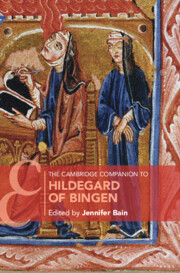Book contents
- The Cambridge Companion to Hildegard of Bingen
- The Cambridge Companion to Hildegard of Bingen
- Copyright page
- Dedication
- Contents
- Figures
- Tables
- Music Examples
- Contributors
- Acknowledgments
- Introduction
- Part I Life and Monastic Context
- Part II Writings and Reputation
- Chapter 4 Hildegard of Bingen’s Theology
- Chapter 5 Reading Hildegard of Bingen’s Letters
- Chapter 6 From the Roots to the Branches: Greenness in the Preaching of Hildegard of Bingen and the Patriarchs
- Chapter 7 Hildegard of Bingen: Illness and Healing
- Chapter 8 The Pentachronon and Hildegard of Bingen’s Reputation As a Prophet
- Chapter 9 The Context and Reception of Hildegard of Bingen’s Visions
- Part III Music, Manuscripts, Illuminations, and Scribes
- Select Bibliography
- Index
- Cambridge Companions To …
- References
Chapter 9 - The Context and Reception of Hildegard of Bingen’s Visions
from Part II - Writings and Reputation
Published online by Cambridge University Press: 28 October 2021
- The Cambridge Companion to Hildegard of Bingen
- The Cambridge Companion to Hildegard of Bingen
- Copyright page
- Dedication
- Contents
- Figures
- Tables
- Music Examples
- Contributors
- Acknowledgments
- Introduction
- Part I Life and Monastic Context
- Part II Writings and Reputation
- Chapter 4 Hildegard of Bingen’s Theology
- Chapter 5 Reading Hildegard of Bingen’s Letters
- Chapter 6 From the Roots to the Branches: Greenness in the Preaching of Hildegard of Bingen and the Patriarchs
- Chapter 7 Hildegard of Bingen: Illness and Healing
- Chapter 8 The Pentachronon and Hildegard of Bingen’s Reputation As a Prophet
- Chapter 9 The Context and Reception of Hildegard of Bingen’s Visions
- Part III Music, Manuscripts, Illuminations, and Scribes
- Select Bibliography
- Index
- Cambridge Companions To …
- References
Summary
Outside the Rhineland, Hildegard of Bingen’s twelfth-century contemporaries knew her primarily as a visionary. Even today, when she is studied as a musician, theologian, linguist, and naturalist, interest in her visions is still strong in both academic and popular circles. This chapter places her visions in the context of twelfth-century Christian visionary activity, where they were remarkable but far from unique, and then traces their distinctive use and transformation by successive generations of readers up to the present day. Even as many of Hildegard’s works fell into disuse, her best-known visions and her reliable reputation as a trustworthy visionary – sometimes attached to visions written by others – remained popular. The visionary Hildegard reappeared again and again: in fourteenth-century debates over prophetic authority, in sixteenth-century broadsides on church reform, in twentieth- and twenty-first-century appeals to medievalism, New Age spirituality, feminism, and ecotheology. Whether Hildegard’s enthusiasts viewed her as a critic or a champion of the institutional church, they were always certain that her visions had something valuable to offer their present moment.
- Type
- Chapter
- Information
- The Cambridge Companion to Hildegard of Bingen , pp. 189 - 206Publisher: Cambridge University PressPrint publication year: 2021



